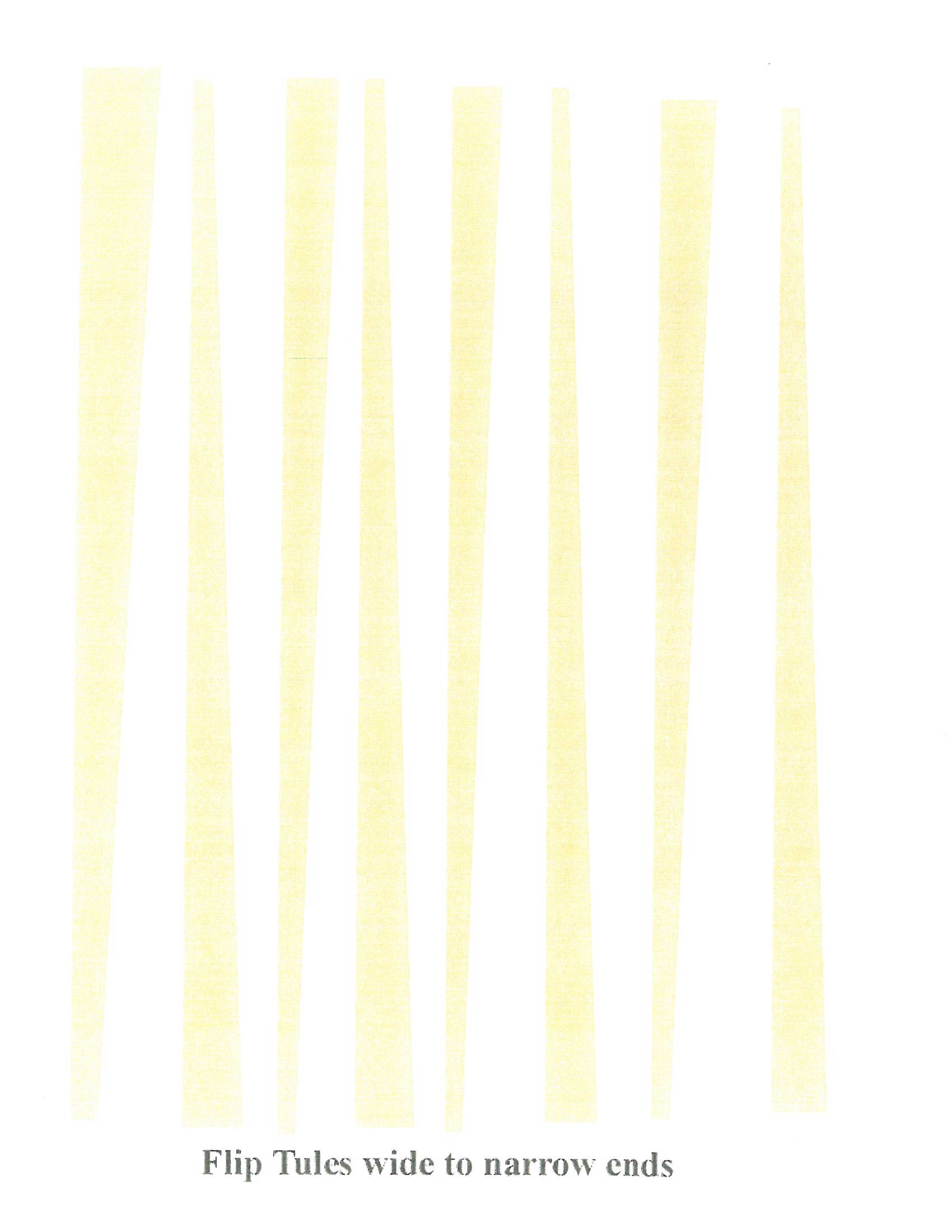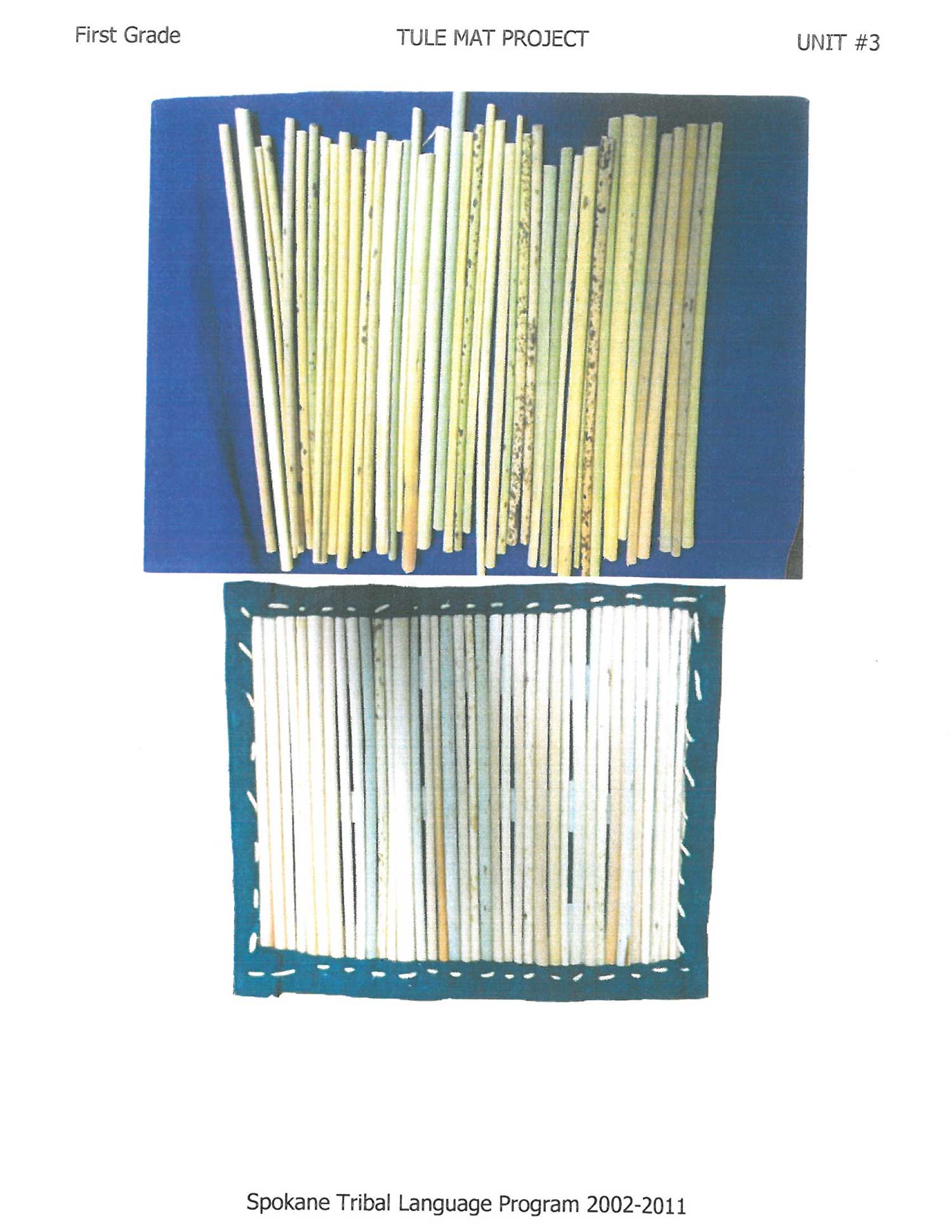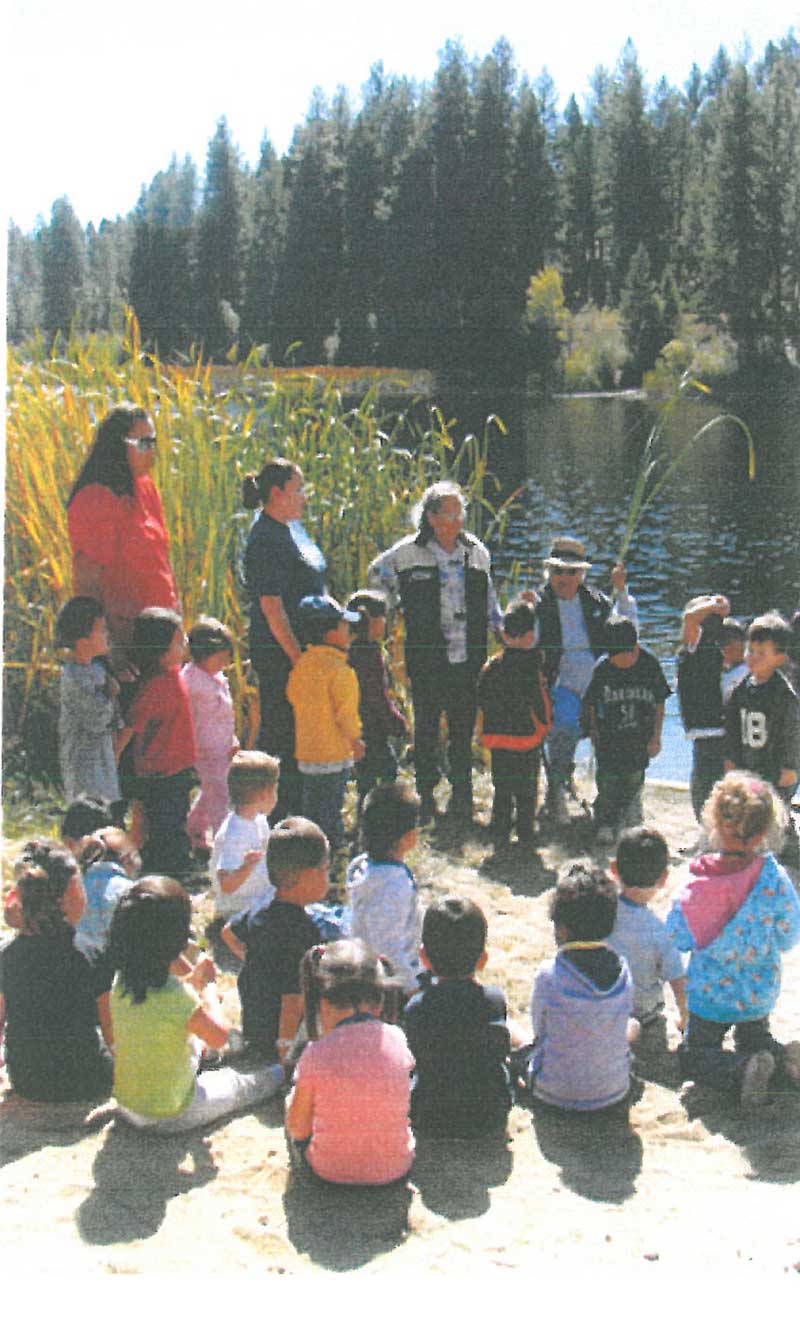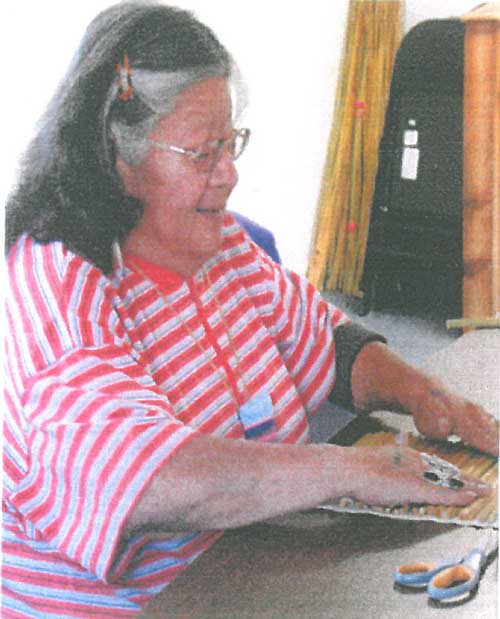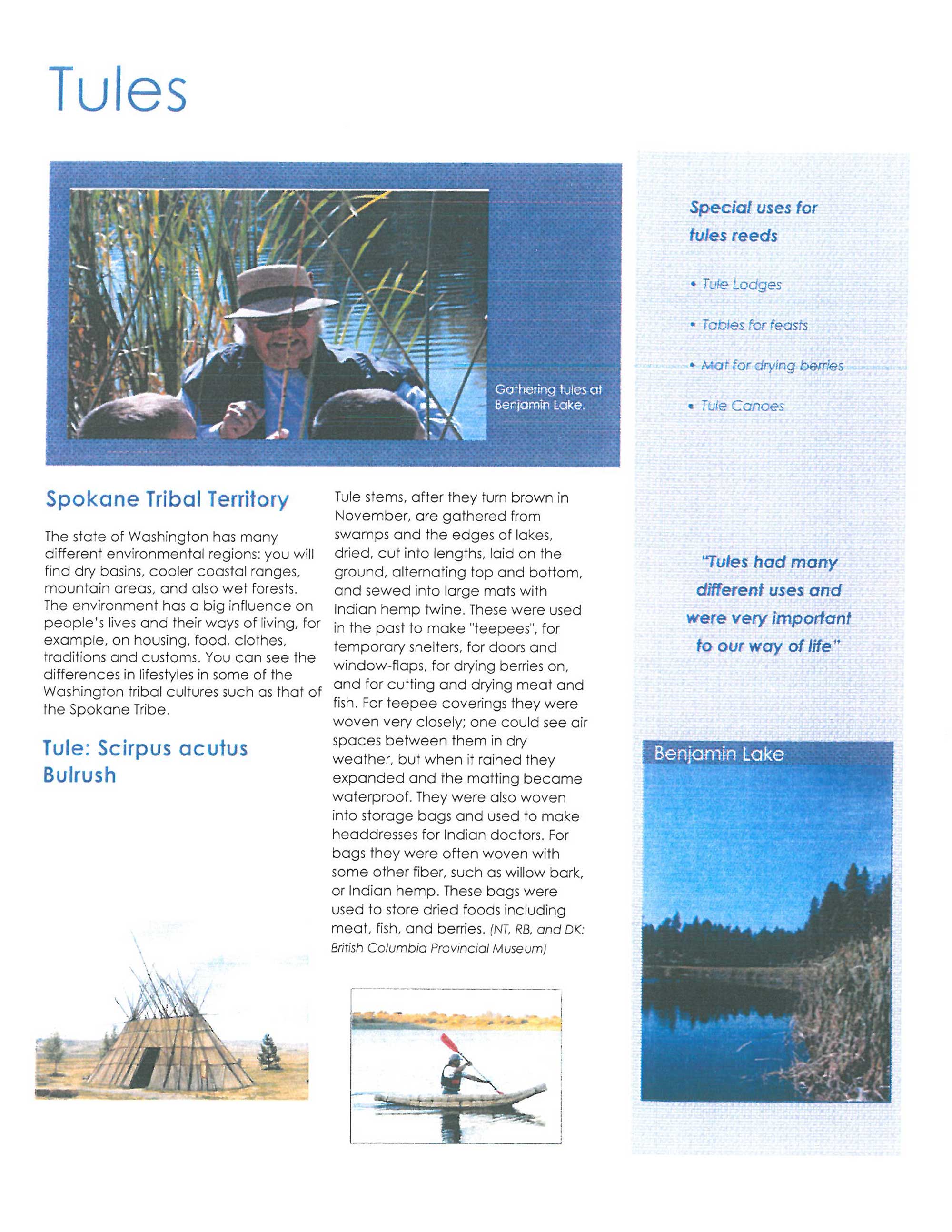Tule Mat Project
Tule Mat Project
Grade Level:
1
Scope & Sequence:
Tule Mat Making
Goal:
Students will review animals and learn how to sew tules. The first tule mat should be given to an elder (parents, grandparents, aunts, uncles, etc.). They can give the mat for Christmas.
Objective:
Students will:
- Sew a tule mat.
- Measure using a ruler.
- Learn traditional way of measuring.
- Understand that a different pattern is created depending upon which ends of the tules are laid together.
- Prepare to build large teepee.
- Count to 15
Background Knowledge / Cultural Concept
Spokane Tribal Values
- Respect
- Land-Environment
- Relationships
Vocabulary
- sq̓ʷastqin (tule)
- sq̓ʷastqin (cattail)
- čłq’liʔ (lake)
- sčkʷltasq̓t (Isaac Benjamin-Red Sky)
- sy’qsełxʷ (tule tipi)
- yaʕ’ (gathering)
- łamayeʔ (frog)
- pisł (trout)
- xʷixʷey’uł (birds/animals)
- pišłp (cattail leaves)
- sčkʷlkʷltetkʷ (Benjamin Lake)
- sy’ay’qs (tule mat)
- p’rq’q’ew’ (Yellow headed Blackbird)
- čłq’y’e ƛ̓’čƛ̓’ač’ (Red winged Blackbird)
- Eagle
- Hawk
- Swan
- Duck
- Goose
- Turtle
- Snake
Lesson Plan
The teacher will:
Review animals that students saw at Benjamin Lake.
Ask students what tules were used for a long time ago and what they are used for today. Teacher will show the students a tule mat and demonstrate how the tule mat is used as a traditional “table” on the floor for root feasts and special dinners. The teacher will also show children a photo of a tule lodge (tepee) and explain that they are going to make one in the winter. Today they are going to learn how to sew the tules by making a mat.
A small tule lodge model will be available for the children to see. (Available at Language Program)
Assessment:
- Pretest: Ask the students to identify a tule. Ask them what the tule was used for by their ancestors and what they are used for today. Ask students what would happen if the tules got wet.
- Posttest: Students will complete a sewn tule mat and identify which elder they will give it to and when.
- Sewing instructions
- Finished mat diagram
Enrichment:
After the mats are sewn, you can let the students wet them to see what happens and to review the lesson from Kindergarten. Have them look through the tules when dry and then experience the water-tightness that comes after the tules expand when wet. Make sure you let the mats dry again before gifting.
Materials Needed:
- Tules 15 each students
- Ruler
- Fine magic marker for marking tule to cut
- Scissors for cutting tules
- Wood needle – get from Language Department
- Hemp twine
Activity:
Brief Description:
Pre-cut tules to fit the width of the felt. Have students glue each tule and place one right below the other.
Students will make small tule mats in a brief art project. Each student will receive one piece of 8.5″ x 11″ construction paper and 10 tules. Students will measure and cut tules to fit the width of the felt material. Students will glue each tule to felt material horizontally one below the other (see Tule Mat Diagram)
Lesson Assigned To:
- Knowledge of Language, History & Culture
- Standard 1: Ecological, Social, and Economic Systems
- Standard 2: The Natural and Built Environment
- Social Studies 3.2.1
- Science: K-1 APPB
- K-1 APPD
- K-1 PS1A
- K-1 ES2A
- Arts: Students begin to develop an understanding of the elements of art and principles of design by exploring a variety of materials and techniques. They continue to develop their skills, including observational skills, fine motor skills, and sensory connections, by using step-by-step processes to create artwork. They create and respond to visual arts experiences that are meaningful in their lives. Through their experiences with the visual arts, they develop an awareness of their own community and environment.
NGSS
Common Core Standards
College and Career Readiness Anchor Standards for Speaking & Listening:
CCSS.ELA-LITERACY.CCRA.SL.1
CCSS.ELA-LITERACY.CCRA.SL.2
CCSS.ELA-LITERACY.CCRA.SL.6
First Grade Speaking and Listening Standards:
CCSS.ELA-LITERACY.SL.1.1.A
CCSS.ELA-LITERACY.SL.1.2
CCSS.ELA-LITERACY.SL.1.5
CCSS.ELA-LITERACY.SL.1.6
College and Career Readiness Anchor Standards for Language:
CCSS.ELA-LITERACY.CCRA.L.5
CCSS.ELA-LITERACY.CCRA.L.3
CCSS.ELA-LITERACY.CCRA.L.6
Language Standards First Grade:
CCSS.ELA-LITERACY.L.1.1.C
CCSS.ELA-LITERACY.L.1.1.F
CCSS.ELA-LITERACY.L.1.1.G
CCSS.ELA-LITERACY.L.1.1.I
CCSS.ELA-LITERACY.L.1.1.J
CCSS.ELA-LITERACY.L.1.5.C
CCSS.ELA-LITERACY.L.1.5.D
CCSS.ELA-LITERACY.L.1.6
Mathematics:
CCSS.MATH.CONTENT.1.OA.A.1
CCSS.MATH.CONTENT.1.OA.C.6
CCSS.MATH.CONTENT.1.NBT.B.2
CCSS.MATH.CONTENT.1.NBT.B.2.A
CCSS.MATH.CONTENT.1.NBT.B.2.B
CCSS.MATH.CONTENT.1.MD.A.2
CCSS.MATH.CONTENT.1.G.A.1
CCSS.MATH.CONTENT.1.G.A.2
Spokane Tribal Standards
- A.1 – Assume responsibility for their role in relation to the wellbeing of the cultural community and their life-long obligation as a community member.
- A.6 – Live a life in accordance with the cultural values and traditions of the local community and integrate them into their everyday behavior.
- B.4 – Identify appropriate forms of technology and anticipate the consequences of their use for improving the quality of life in the community.
- C.1 – Perform subsistence activities in ways that are appropriate to local cultural traditions.
- C.4 – Enter into and function effectively in a variety of cultural settings.
- D.1 – Acquire in-depth cultural knowledge through active participation and meaningful interaction with Elders.
- D.2 – Participate in and make constructive contributions to the learning activities associated with a traditional camp environment.
- D.5 – Identify and utilize appropriate sources of cultural knowledge to find solution to everyday problems.
- E.3 – Demonstrate an understanding of the relationship between world view and the way knowledge is formed and used.
- E.8 – Identify who they are and their place in the world.

